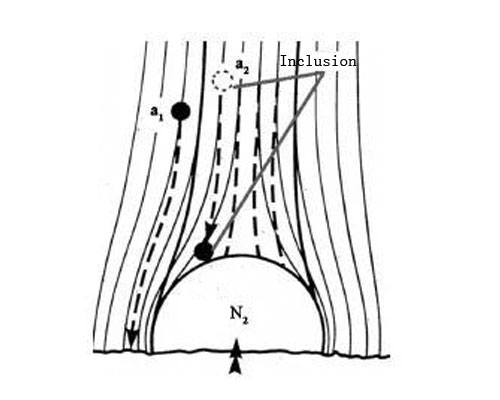Nitrogen refining generally requires a lower temperature of the molten aluminum, although lowering the temperature reduces the diffusion rate of atomic hydrogen in the molten aluminum, it increases the viscosity of the molten aluminum and prolongs the floating time of the bubbles, which is beneficial for hydrogen to nitrogen diffusion in bubbles. At the same time, it can also reduce the tendency of oxidation to get air.
The nature and purity of the gas itself, the density and viscosity of the refined gas, the wetting performance, and heat capacity of the inclusions, have an impact on the nitrogen refining effect. The greater the gas density and the greater the viscosity, the higher the floating speed in the molten aluminum. The slower, the longer the residence time, is conducive to improving the refining effect; but the smaller the gas density, the larger the gas volume per unit weight, and the larger the contact area with molten aluminum, which is also conducive to improving the refining effect. Practice has proved that the decisive role in the degassing process is not the density of the gas, but its volume, degree of dispersion in the molten aluminum, and the size of the bubbles. The smaller the bubble is, the more diffuse and uniform it is, the larger the surface area and the slower the speed of floating in the molten aluminum, thus increasing the gas utilization rate and improving the nitrogen refining effect.
Control of bubble size and uniformity. The size and uniformity of the bubble depends on the gas flow rate and the rotation speed of the rotor in actual operation. Intuitively speaking: if the gas flow is too large, larger bubbles will be generated in the molten aluminum, and the phenomenon of turning over on the surface of the molten aluminum will easily re-enter the floating impurities into the molten aluminum, resulting in waste of refining work and affecting refining effect: The amount of gas introduced is too small, and the number of bubbles that can play a refining effect in the molten aluminum is limited, and the desired effect is also not obtained.

The rotation speed of the degassing unit rotor should be maintained at a high level so as to produce fine and uniform air bubbles that are dispersed and distributed throughout the solution. When the rotation speed is too low, larger bubbles are generated, which accumulate around the rotor, reducing the specific surface of the bubbles. Too high rotational speed is easy to cause eddy currents on the surface of the molten aluminum centered on the rotating rod, which will re-enter the floating impurities into the molten aluminum. At the same time, it will also affect the service life of the rotating rod.

